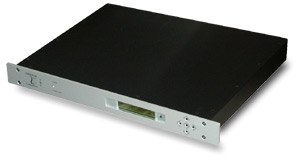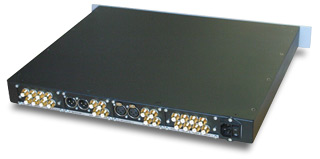![[SoundStage!]](../sslogo3.gif) Surrounded! Surrounded!Back Issue Article |
|||||||
Surrounded by smart people Finding good food in Germany when you don’t eat red meat or pork is not easy. Earlier this year while covering the Frankfurt-based High End 2002 show for our A/V Tour 2002, Doug Schneider and I made a terrific discovery: a restaurant only a few blocks from our hotel that had some really good Chinese food. We had eaten there a couple nights in a row already when we decided to go yet again and partake with some new acquaintances we had made at the show. It was to be an enlightening experience. But before I tell you about that, some background is in order. Probably the best part about covering audio shows is not the fancy gear, but meeting the people that design it. I treasure talking to the talented folks that make this stuff. Usually they revel in the opportunity to share their knowledge, and I never fail to take the time to listen and learn. What could be better? And when you’re at a show in Europe, there’s a unique flair in the people’s personalities that you just don’t get anywhere else. I got one such opportunity while listening to the fantastic Amphion line of loudspeakers in a room hosted by head Amphionite Anssi Hyvonen. The kind gentlemen at Globe Audio Marketing (North American distributors for some fine European products, including the one under test here) introduced Doug Schneider and me to the principals at the Swiss-based electronics manufacturer Orpheus Laboratories, then sharing a room at the Kempinski Hotel with Amphion. Daniel Oertli and Florian Cossy are two enthusiastic guys who love what they are doing -- they’re doing a lot -- and it shows in their demeanor. Orpheus Laboratories produces an entire brace of electronics: amplifiers -- both stereo and monoblock configuration -- a preamp, and a digital-to-analog converter. They also have a business-to-business company called Anagram Technologies, makers of the STARS "resampling" chip that is a top-secret potted module that some of the best digital components in the world are using.Seems some of these Orpheus guys were once with fellow Swiss audio manufacturer Goldmund, a very progressive company itself, before making the jump to their own gig. And they brought more than a few tricks with them. When I heard they were making a multichannel preamp with some cutting-edge technology and features, my ears perked up and my eyes flashed around the room looking for what was to become the object of my desire. Back at the restaurant… It wasn’t until we were at the German Chinese restaurant eating some American food (Hawaiian chicken) that I really became impressed with the brain trust at Orpheus, and it was because of a question that Doug Schneider laid on the table -- probably not expecting the answer he got. "What exactly is upsampling?" How many times have you asked that question and gotten a straight answer? Very few if you’re like me. I have heard numerous explanations, each a little different and each somehow incomplete. Not this time. Florian Cossy, when asked, grabbed a napkin and a pen and began expounding his version (called "resampling" by Orpheus/Anagram). Expecting a 30-minute diatribe in engineer-speak that made no overall sense to me, I listened intently. Well, and this is a big well, in five minutes this digital engineer broke down the concept in layman’s terms (several notches below the engineering version in word value) so that a clear understanding was taken away by all. How did he do it -- take a complex subject, explain it in terms we all understood using only a pen and a napkin, and accomplish it in five minutes? I still don’t know, but it did convince me that if he could do this, he could design a multichannel preamp that would dazzle even more. A configurable preamp Don’t think of the Orpheus Laboratories Two, $6720 USD, as a great multichannel preamp. Think of it as a great preamp that happens to be so thoughtfully designed that the makers included the ability to program it for different system configurations. It’s a configurable preamp -- a new term coined right here in "Surrounded!" -- and it makes no functional concessions because it can handle high-resolution sources in all their multichannel splendor. Visually, the slim-line Orpheus Laboratories Two reminds me of a well-made piece of professional gear. It’s solid as a brick, functions without a hitch, and doesn’t scrimp on parts quality. The RCA and XLR input and output jacks are all fastened to the rear panel, not just routed through holes to mount on the circuit board alone. The faceplate is aluminum and the chassis appears to be made from heavy-gauge steel. The remote even has an aluminum face and rubber feet for coffee-table sitting. There’s not much to tell about the faceplate. It’s simple and intuitive. There is a diamond array consisting of four small buttons with a single button in the middle. The top and bottom buttons control volume and value levels for the various parameters; the left and right buttons control functions and inputs, as well as scanning through the menu system; the middle button toggles between stand-by and on, and selects the operation you want performed (kind of like an "enter" button). The display window appears small, but don’t let that fool you -- a wealth of information is at your fingertips. You can even name sources what you want because the display is programmable, which may help users with complex systems identify what is playing (plus it’s just plain cool). The display is adjustable too -- you can set the exact brightness level to suit your taste. The main-power rocker-switch is on the rear panel, so it doesn’t clutter the face. And although it just seems too narrow for them all, there’s a host of inputs and outputs available on the rear panel. This is also where you’ll learn about the Orpheus secret weapon -- but not yet. There are six pairs of stereo inputs on RCA connectors, a single set of balanced inputs and outputs on XLR jacks, as well as a tape monitor in and out. And there are two sets of RCA outputs for driving, say, a biamped system or a powered subwoofer.
How is that possible, and what do I mean by "or two if you like"? Configurable, it’s configurable! Those six pairs of RCA jacks can be configured for single multichannel, which is one set of six-channel inputs and three sets of stereo inputs, or dual multichannel, which would give you two sets of six-channel inputs. And even in this configuration you still have a set of balanced stereo inputs. Let me be perfectly clear: Each set of three stereo inputs can be converted to one set of six-channel inputs, and back again, with some simple steps explained in the manual. It’s just plain clever. You make it work for your system; buy the Orpheus Laboratories Two and use all the inputs for myriad stereo sources and never even tap into its multichannel capabilities, and still not waste any inputs. Or you can have one of the most functional preamps I’ve ever seen for use in a complex multi-source, multichannel-music and home-theater system. Brilliant, just brilliant. There’s a host of other features too. You can set a passive filter to cut the ultra-high-frequency noise apparent in some high-resolution recordings. The input levels are also adjustable for components with varying output voltages. It’s a chameleon. The Orpheus Two is configurable in many ways, which should make it adaptable to almost any system. Straight wires with gain Wires? Well sure, it is compatible with multichannel music after all. And it sounds dead neutral as far as I can tell. If you need euphony, a tone control, or that warm-and-fuzzy feeling about a component, don’t look to the Orpheus Laboratories Two. In fact, I suspect that Orpheus will find as much favor in the pro market with a piece like this as anywhere else. It just passes the signal without so much as a hint of coloration. And that makes it valuable in a lot of places.
Listening to Swing Live [Chesky CHDVD222] on DVD-Audio, still my reference for multichannel sound, I couldn’t detect any coloration that I know is not inherent to the other components I am using. The noise floor is so low as to render it nonexistent in day-to-day use, the midrange is clear as a bell, and the highs are ultra detailed without etch, grit, or hash. I don’t have the subterranean bottom end I had with my Wilson X-1 Grand SLAMMs; I’m now using the Dynaudio C-2 loudspeakers in my temporary listening space (read about that in last month’s "Surrounded"). But as low as they do play, the Orpheus is there accompanying them without complaint. The Dave Matthews Band’s Crash [RCA 07863 66904-2], particularly "Say Goodbye," is a system killer with ultra-tight, quick transient attack. The Orpheus Laboratories Two-based system breezed through the Crash test without a whimper and without dulling the bombardment of Carter Beauford’s drum solo in the first minute of playing time. This is a song that would translate well into multichannel; if only more mainstream releases would make it to either of the current formats. With good ol' two-channel recordings, the Orpheus Laboratories Two succeeds as well as any preamp I’ve heard. Rebecca Pidgeon’s "Spanish Harlem" (The Raven [Chesky JD115]) is delivered with pristine sound quality -- the kind that makes you think less about the system and more about the music. Pidgeon's vocals just float through the air without any impediment related to electronic veiling. Like I said, dead neutral. Just to make sure I didn’t miss anything, AIX Records’ newest release The Latin Jazz Trio [AIX 80011] was given a thorough run through, with percussion, piano, and bass taking center stage. Again, I just could not find fault with the sound quality portrayed by the Orpheus Laboratories Two. There was plenty of body, yet crystalline clarity that just let the music flow through in an organic way. The piano was full of tonal color, the bass was fast and weighted properly, and the bass was not blurred in any way. Sounds were easily differentiated from each other but the whole remained an intact entity. This is the way I wanted the music presented, and the Orpheus Laboratories Two gave it to me. Upshot The Orpheus Laboratories Two is a reference-caliber preamp. Period. It also is configurable for a variety of systems -- it can grow or shrink or mutate with the push of a few buttons. It is the consummate audiophile component with the functionality usually attributed to the better theater-pass-through stages of home-theater-based processors. What else can I say? If you want something that does not sacrifice sound quality or functionality and has a healthy dose of ingenuity designed in by some really smart Swiss engineers, buy the Orpheus Laboratories Two configurable preamp. You’ll not regret it. ...Jeff Fritz
|
|||||||
|
|||||||
![[SoundStage!]](../sslogo3.gif) All Contents All ContentsCopyright ę 2002 SoundStage! All Rights Reserved |



 But that’s not all.
You’ll get a set -- or two if you like -- of six-channel inputs for use with a
DVD-Audio player and SACD player.
But that’s not all.
You’ll get a set -- or two if you like -- of six-channel inputs for use with a
DVD-Audio player and SACD player.